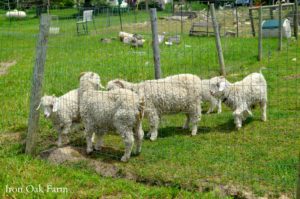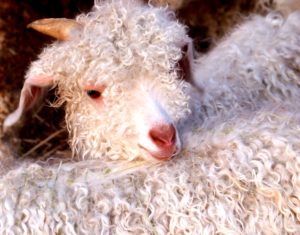Basic Facts About Raising Angora Goats
 When I was a girl, I was fascinated with the process of spinning yarn. I’m not exactly sure where the notion came to me. I faintly remember watching a children’s program that showed the process, maybe Mr. Roger’s Neighborhood?
When I was a girl, I was fascinated with the process of spinning yarn. I’m not exactly sure where the notion came to me. I faintly remember watching a children’s program that showed the process, maybe Mr. Roger’s Neighborhood?
I remember taking the dog’s 2 slicker combs and trying to work cotton balls between the two brushes like I had watched the lady in the show do with wool. All it did was make a giant knot, and as my mother shook her head, I spent the afternoon picking shredded cotton out of the dog brush.
I was not easily discouraged and from a very young age, I decided that I wanted to raise sheep…or so I thought.
Fast forward 10-12 years. At this point, I was actually old enough to where raising sheep might be a possibility. I started doing research and found that sheep seemed to be rather delicate creatures. I rented a book from the library (pre-internet days) on how to raise sheep and the section on possible diseases that sheep can get was larger than the rest of the book combined.
This left me weary. I know that I get really attached to animals and I didn’t know if I wanted to raise a breed that I could lose to death for something very small.
I’ve since learned that these diseases are not as common as they once seemed. At the present, I would not be wary about adding sheep to our farm at all. But at the time it seemed scary.
 In my research, I found that there was such a thing as a fiber producing goat. I had no idea!
In my research, I found that there was such a thing as a fiber producing goat. I had no idea!
According to quite a few sources, goats were a much more hearty animal compared to sheep. So I switched gears and learned everything I could about Angora and Cashmere goats. Which wasn’t a lot.
There still isn’t a ton of information out there on raising fiber goats. A lot of our knowledge came from reading information on dairy goats and pairing that with the fiber production of sheep.
But mostly, we decided to jump in and over the years we’ve collected a wealth of knowledge through trial and error. It’s my hope that over the next few posts I can help solve some of the mystery around these amazing animals and help you to learn to make a profit.
In the everyday care of fiber goats, it’s much like raising any other goat. They have a very mild temperament, and though they might be hardier than sheep, they are the most delicate of goat breeds.
Why are Angora’s Delicate?
 Angora goats are the most productive fiber animal in the world. They are shorn twice a year and produce a very soft, very insulated fiber. All that fiber production takes a lot of energy from the animal.
Angora goats are the most productive fiber animal in the world. They are shorn twice a year and produce a very soft, very insulated fiber. All that fiber production takes a lot of energy from the animal.
Offspring and Lactation
 Does will often produce only 1 offspring per season. Angora mothers have been known to not produce enough milk if they give birth to more than 1. We’ve taken milk from our Nubians and fed it to our Angora kids to give them a head start.
Does will often produce only 1 offspring per season. Angora mothers have been known to not produce enough milk if they give birth to more than 1. We’ve taken milk from our Nubians and fed it to our Angora kids to give them a head start.
 Additional Nutrition
Additional Nutrition
The most important thing to realize about fiber goats is that they need extra nutrition, mainly in the form of fats to make lanolin to protect their mohair and protein to grow those long locks.
- Quality grass hay
- Quality goat feed at 14% protein level min. They also do well with the addition of alfalfa hay, or beet pulp.
- Black oil sunflower seeds for needed oils for the production of lanolin.
- Quality minerals with copper offered free choice
- Baking soda offered free choice for digestive health
Parasite Control
 Parasite loads are harder on Angoras. I find I need to worm them more regularly than the dairy goats and that their wormer needs to be changed up more often to be effective.
Parasite loads are harder on Angoras. I find I need to worm them more regularly than the dairy goats and that their wormer needs to be changed up more often to be effective.
Like all fiber animals, Angoras are prone to lice infestations. We check their skin and fleece regularly to check for lice nits and eggs. Regular de-lousing is essential. Lice will negatively impact health and the quality of the fleece.
NEVER De-horn
 A goat’s horn is not just used for defense they also serve as the animals’ cooling system and body temperature regulation. If you’ve ever touched a goat’s horns, you’ll notice that they are usually warm. They are not just dead protein like a fingernail, but instead, have a blood supply and serve an internal function.
A goat’s horn is not just used for defense they also serve as the animals’ cooling system and body temperature regulation. If you’ve ever touched a goat’s horns, you’ll notice that they are usually warm. They are not just dead protein like a fingernail, but instead, have a blood supply and serve an internal function.
If you de-horn an Angora, it will overheat in warm weather under all that fiber.
All the Goats are Useful
In the dairy goat world, there is the question, “what to do with the male offspring?”
In the Angora world, the wether (neutered male) is the most valuable. The energy it takes for intact males and does to produce reproductive hormones actually affects fiber production. You will get the best fleece and longest fibers from wethers.
Use Straw for Bedding
When it comes to bedding for our animals I prefer pine flakes. They’re easy to shovel and the pine oils make for a fresh smelling stall. However, with Angoras, the flakes become embedded in the fleece and make a mess when it comes to processing the fiber. Because of this, we use straw with our Angoras.
Rain
Most every goat I know hates rain! Angora goats especially need shelter from rain because their fleece will fill with water and in cooler temperatures, they can develop pneumonia. A dry shelter is particularly important for Fiber goats.
Check back for my next post on making money with Angora Goats for how-to’s on shearing, processing the fiber and marketing.











5 Comments
Very well written and informative!
I really enjoyed this first part, it was quite informative. However, I can’t find the other parts. I went to the website for the author and nothing. That’s quite frustrating. I really could use the information.
I Googled Making Money with Angora Goats Jennifer Sartell and found parts 2, 3, 4; so have been a blessing to pull them up and read them. It would be nice to have a link to this article for the others. I find the articles easy to read and follow and they are very informative. Thanks for the information!!
Jennifer, thanks for your article, but please have someone proofread.
“Heartier” should be hardier.
“Black sunflower oilier seed” should be Black Sunflower Oil seed.
Thanks
Thank you Michael. We appreciate your feedback and will keep working to make our articles as accurate as possible and to keep checking posts from our community members. We can all use editors. 🙂